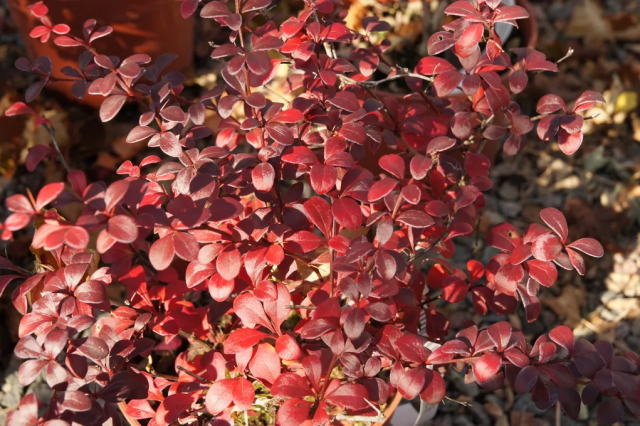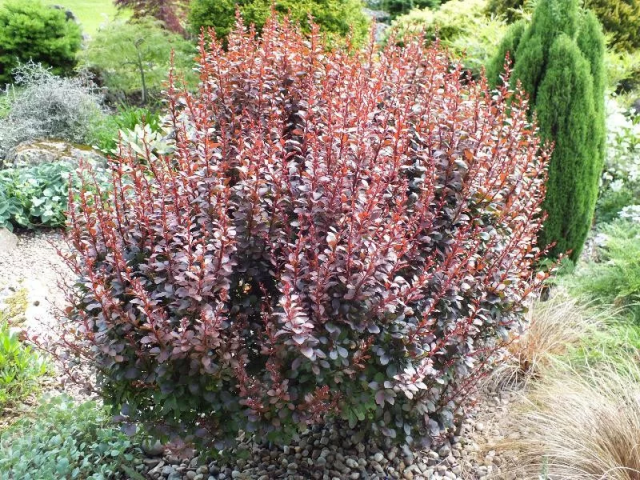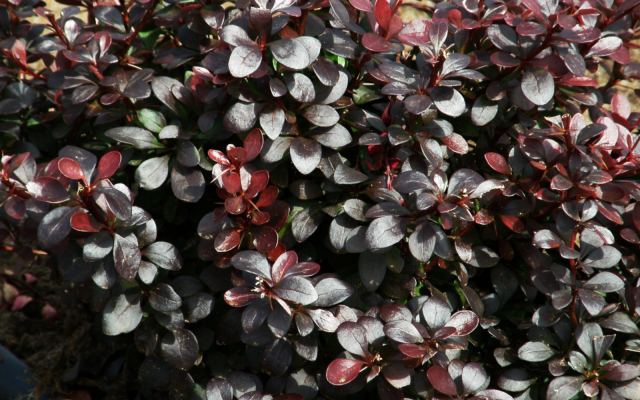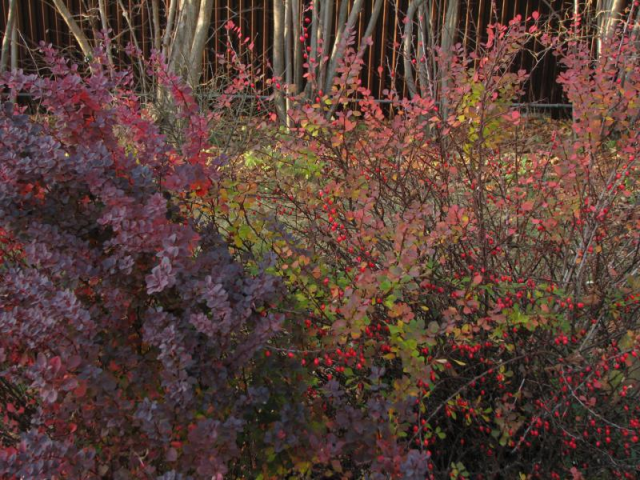Content
Barberry Thunberg Darts Red Lady is a plant with decorative properties. It is appreciated for its unusual leaves that change color throughout the season. This variety has high winter hardiness and rarely gets sick.
Description of barberry Darts Red Lady
Barberry Thunberg is a species of the genus Barberry, it grows in nature in the Far East. It is also grown in Europe and North America. The variety is planted in gardens and parks throughout Russia. The shrub grows successfully in the middle lane, in the Urals and Siberia.
According to the description of the Thunberg barberry Darts Red Lady is a deciduous shrub. The crown is wide and rounded. Plant height from 1 to 1.5 m, crown size - up to 1.5 m. Average growth, about 10 cm per year. On the trunk and shoots there are needles collected in bunches.
As you can see in the photo, the branches of the Barberry Darts Red Lady variety are ribbed, in the form of an arc, of a reddish color. In an adult bush, the branches turn dark brown. The kidneys are ovoid, reddish in color. The leaves are small, rounded, located on petioles. The leaf plate reaches 2 cm in length and 1 cm in width.
The flowering of the Red Lady variety begins in the second half of May. The flowers are small, yellowish with red stripes with a weak aroma. The foliage is purple in summer and orange-red in autumn. Small coral-colored fruits ripen in autumn. They remain on the shoots until spring.
Planting and leaving
The successful development of the Thunberg barberry largely depends on the observance of the terms and rules of planting. A suitable place is prepared for the Red Lady variety, the structure and quality of the soil are improved. After planting, the barberry is provided with good care: it is watered, fertilized, the crown is cut.
Seedling and planting plot preparation
Barberry Thunberg prefers sunny areas. In the shade, the shrub of this variety develops slowly, and the foliage loses its rich color. It is best to choose a location on the west or south side, protected from the cold wind. Barberry is planted next to a house, a fence or on a lawn. A hedge is formed from shrubs.
Barberry Darts grows on any soil, but it develops best in loamy soil. The main requirements for the soil are fertility, looseness, moisture and water permeability. If the soil is too heavy on the site, then it is improved with the help of coarse river sand. Excess water in the soil of barberry destroyers.
Strong and healthy seedlings of the Red Lady variety are suitable for planting. They are visually assessed for mold, cracks and other damage. If the roots of the plant are overdried, they are kept in clean water for 5 - 6 hours. In order for the barberry to take root better, a root formation stimulator is added to the water.
Planting barberry Thunberg Darts Red
Barberry Turberg varieties Red Lady are planted in late autumn, when leaves fall. The seedling takes several weeks to take root before it gets cold. In regions with cold climates, the planting of the variety is postponed until the next season. Barberry is kept in a cellar or added to the site. Planting is carried out in the spring, until the buds are swollen on the trees.
The order of planting barberry Darts Red Lady:
- A hole with a diameter of 0.5 m is dug on the site. 1.5 m is left between the bushes. For growing hedges, 2 shrubs are placed per 1 m.
- Expanded clay drainage is placed at the bottom.
- To fill the pit, a substrate is prepared from fertile soil, humus and river sand.
- The pit is covered with soil and left for 3 to 4 weeks for the soil to shrink.
- Before planting a seedling, fertile soil is poured into the pit in the form of a hill.
- A barberry is placed on top, its root system is straightened and covered with earth.
- The soil is tamped, and the seedling is watered with warm water.
After planting, the barberry Darts Red Lady is cut off, 3 buds are left on the branches. In order for the seedling to take root faster, it is watered every 10 days with warm water. To prevent moisture from evaporating, they pour humus or peat.
Watering and feeding
Barberry of the Darts Lady variety is an unpretentious shrub. It is watered only in severe drought. The rest of the time, the culture has enough precipitation. A layer of humus or peat is poured into the trunk circle. Water is taken warm or settled: it is poured under the root. Periodically loosen the soil and weed weeds.
The culture responds well to feeding. In the first years, the seedlings of the Thunberg variety have enough fertilizers applied during planting. In the future, it is best to use organic. In the fall, they dig up the soil under the bushes and add compost.
During the season, the Thunberg bush of the Darts variety is fed according to the scheme:
- in early spring, add mullein infusion under the bush;
- in June, barberry is watered with a solution of superphosphate and potassium sulfate (30 g of each substance per 10 liters of water);
- in late autumn, fertilize with wood ash or superphosphate.
Mineral complexes are suitable for feeding Thunberg barberry. Choose a special fertilizer for ornamental shrubs. They contain all the necessary substances.
Pruning
Due to pruning, the crown of the Thunberg barberry is formed. Darts Red. It is carried out in the spring before the sap flow in the trees. It is allowed to cut the bush in the fall, when the leaves fall. Be sure to eliminate weak, frozen and dry shoots. Anti-aging treatment involves the removal of old branches growing inside the crown.
Formative pruning is performed for hedges. Shoots are cut to 1/3 of the length. Young bushes are pruned annually, adults every six months.
Preparing for winter
Thunberg barberry is resistant to winter frosts. Occasionally shoots freeze, which are removed in spring. In order for the bush of the Darts Red Lady variety to endure the winter better, preparation is carried out in late autumn. The soil is watered with warm water. Wet soil freezes worse and protects the roots from cold weather. The soil is mulched with humus or peat.
Young barberry Thunberg is covered with agrofibre. A wooden frame is installed above the seedlings and a covering material is attached to it. It is not recommended to use polyethylene, which is impervious to air and moisture. In the spring, after the temperature rises, the shelter is removed.
Reproduction
Breeding methods for barberry Thunberg Darts Lady:
- Seeds. The most time consuming option. First, the seeds of the Darts Red Lady variety are harvested, ripening in the fruits. Of these, only 15 - 40% have germination. The shell is cut at the seeds and planted in the ground in the fall. Shoots appear in the spring. After 2 years, the Thunberg seedlings can be transplanted to the desired location.
- Cuttings. In the shrub of the Thunberg Lady variety, branches are cut off with a length of 15 cm. Lignified shoots or green annual cuttings are chosen. The branches are kept in a growth stimulant solution, after which they are planted in boxes with soil. When the cuttings are rooted, they are transferred to an open area.
- Layers. In the spring, a long, strong branch is chosen from the Thunberg barberry. It is fastened with brackets and covered with earth. All season the cuttings are watered and fed. In the fall, the seedling is separated from the bush and planted.
- By dividing the bush. The method is convenient for transplanting Thunberg barberry. The rhizome is divided into parts with a knife, the cuts are treated with charcoal. The Red Lady variety is propagated by dividing the bush in the autumn and spring.
Diseases and pests
The variety is resistant to diseases and pests. With high humidity, the culture can suffer from fungal diseases: spotting, powdery mildew, rust. The mottling takes the form of dark spots on the leaf blade. Gradually, the foliage dries up and falls off. Copper oxychloride solution is effective against the disease.For 10 liters of water, measure 30 g of the substance and spray the leaves of the barberry.
Powdery mildew has the appearance of a whitish bloom that appears on the leaves and shoots of the Darts Lady variety. For the disease, a solution of colloidal sulfur is used. Signs of rust are orange spots on the leaf plate. On the back of the leaves are fungal spores. The disease develops rapidly, which leads to drying and falling of the leaves. To combat rust, Bordeaux liquid is used for spraying.
Barberry Darts Red attracts aphids and moths. Aphid colonies live on the top of the shoots, where the leaves curl, and feed on the juices of the bush. The moth feeds on the fruits of the plant, which fall ahead of time. Pests damage the decorative effect and inhibit the development of the bush. To combat insects, insecticides Actellik or Iskra are used. From folk remedies, spraying the bush with an infusion of tobacco dust is effective.
Conclusion
Barberry Thunberg Darts Red Lady is an ornamental plant that will decorate any garden. It is grown in regions with different climates. The plant requires a minimum of care, it is less susceptible to diseases and does not freeze in winter. The variety is grown throughout Russia.













